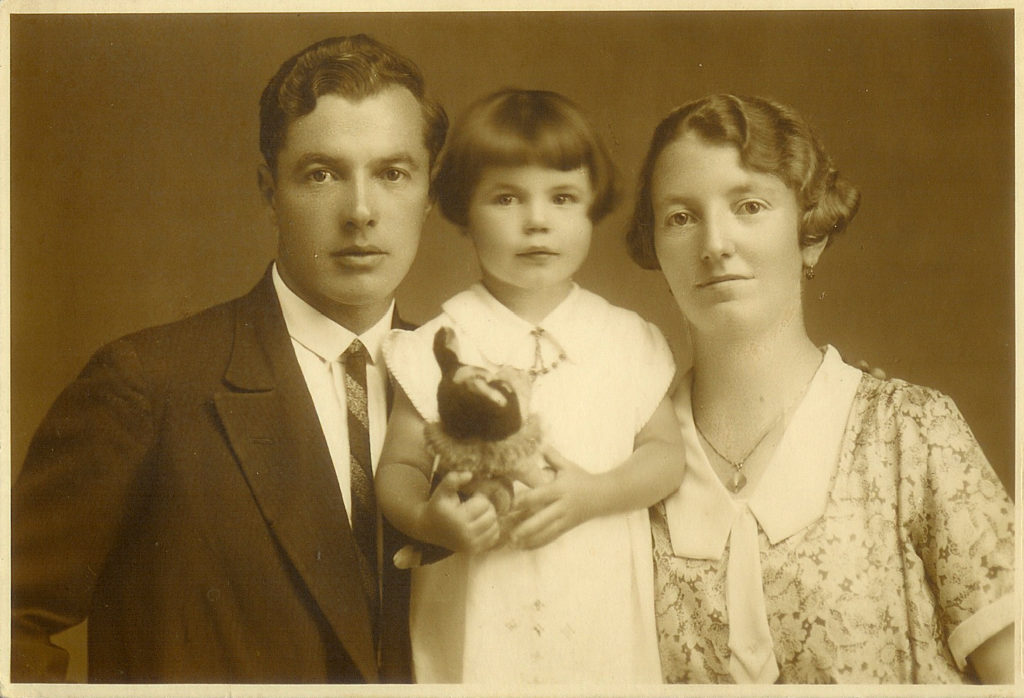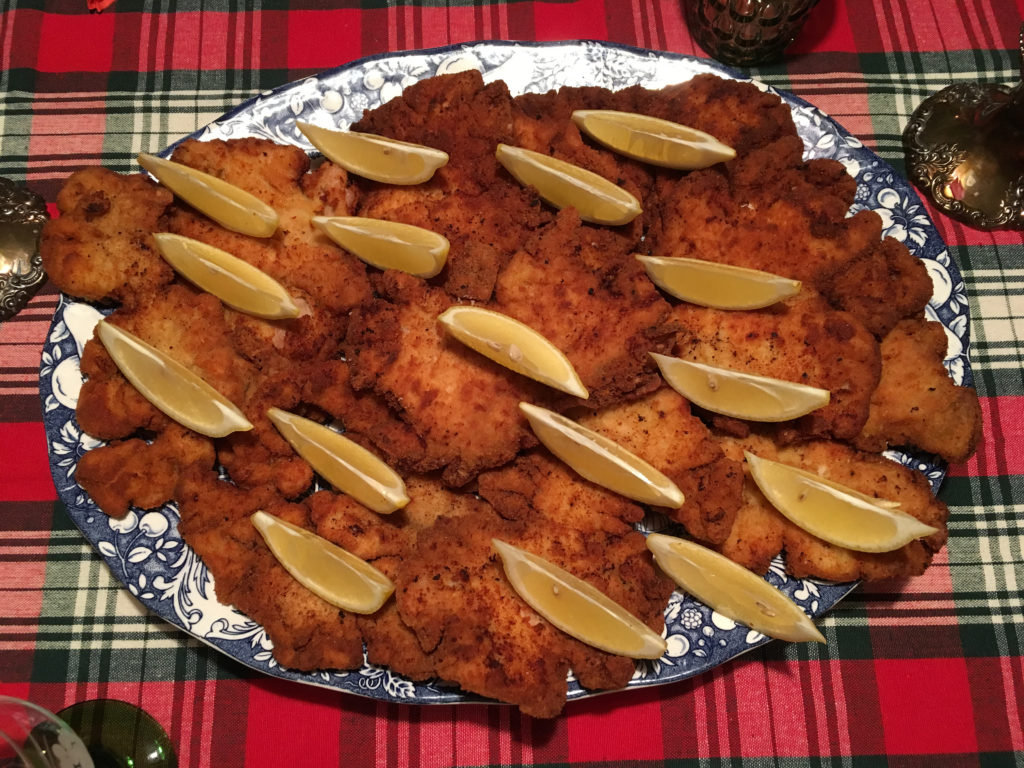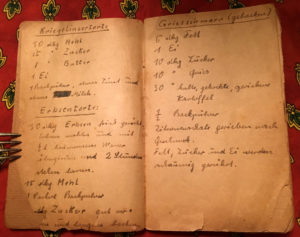By Michael Garval (Regular Contributor)

Friederike Garval (née Kajapic), with her parents Friedrich Kajapic and Anna Kajapic (née Wrba).
My mom was born in Vienna, in 1929: a bad time in a place known for good food.
Her parents embodied the twin pillars of Viennese cuisine: cosmopolitanism and terroir. Her dad came from the Bosnian city of Mostar, the son of a Slovenian-born Habsburg tax collector; her mom, my Oma, grew up in a small farming village in the Weinviertel, the wine-producing region outside Vienna. Like provincials everywhere, my maternal grandparents came to the capital seeking a better life. But times were tough, and they struggled.
When people learn of my Viennese heritage, visions of Wiener Schnitzel, goulash, and Sachertorte waltz in their heads. The reality of my grandmother’s cooking was far more frugal, but no less delicious. I know, since at least some of it was familiar fare for me as a kid in suburban New Jersey in the 1970s. My American dad’s fertile imagination exceeded his business acumen, so money could be tight, and my Viennese mom made ends meet with economical dishes from her childhood.
Viennese table
What kind of food did my grandmother prepare in the 1930s and 40s?
There were vegetable-based soups, purees, and stews, like bean goulash, or lentils spiked with whatever bits of smoked meat could be afforded. And there was an impressive assortment of starches, oft served not as sides but as gut-filling main dishes: all manner of dumpling, both savory and fruit-filled; thick crêpes called Palatschinken, filled with marmalade; potatoes prepared many ways, including as Erdäpfelschmarrn, a kind of hash, sometimes mixed with cubes of streaky bacon; and toothsome homemade noodles that I watched my Oma make in her modest Vienna apartment, the dough rolled thin across the kitchen table, then sliced with the deft fingers of one who’d cooked professionally (in the 1920s, this country girl in the big city worked at a restaurant in the upscale Annagasse, then at a canteen for soldiers, which is where my grandparents met).
Meat was scarce. For my mom’s mid-morning snack at school (Gabelfrühstück), Oma might pack her a Wurstbrot, an open-faced sandwich made with Burenwurst, a garlicky, rustic, and above all inexpensive sausage. Her persnickety teacher would sniff out the pupils’ garlic sausage provisions, and exiled these to the space in between the classroom’s double windows, to be returned only at snack time. Much of the time, however, there was only lard to spread over bread (Schmalzbrot), and my mom didn’t like this as much, even if it gave her schoolmistress’ fussy nose a rest.
Despite hard times, this was Vienna, and Sundays still meant schnitzel, though with horse cutlets, since ration coupons bought twice as much horse meat as any other kind. Perhaps betraying his bourgeois origins, or just out of sympathy for the fine animals, my grandfather objected to horse meat, so my grandmother didn’t tell him. The flesh was lean, tender, and tasted much like veal, so her secret remained safe.

Pork Wiener Schnitzel prepared by Friederike (“Fritzi”) Garval, Chapel Hill, North Carolina, Christmas 2016.
Only on Christmas Eve did they have pork schnitzel, dredged in homemade bread crumbs (stale bread couldn’t go to waste), and fried to crisp, golden perfection.
Home front
Toward the end of the war, things got tighter still. There was a windfall of sorts however when a local factory was bombed, and the owners gave their stock to neighbors, rather than abandoning it to the advancing Russians. For months, my mother’s best friend Hermi and her siblings consumed their share of the factory’s noodles and jam: an all-carb diet that left them wan and pasty, but alive.

Anna Kajapic, kitchen notebook (mid-20th century)
Mom’s family was luckier. Oma’s country roots meant they could go work on relatives’ farms, in exchange for provisions, especially meat. From the December pig slaughter they got preserved and fresh pork (whence the Christmas schnitzels), stored over the winter months in the snowy flower box outside the window of my grandparents’ tiny Viennese apartment. They also brought back miraculous harvests of wild mushrooms, especially chanterelles (Eierschwammerl), from the Waldviertel, the wooded region just beyond my grandmother’s native Weinviertel.
After the war, the Marshall Plan sent nourishing though strange items: cans of silver hake, no longer needed as military guard dog food; or peanut butter which my grandmother, recognizing the German word Butter on the label, tried unhappily to use for frying. The Russians sent surplus dried peas, so worm-ridden that they looked like beads, and needed a preliminary soaking to chase out the vermin. The Austrians called them Russische Erbsen, or Russian peas.
Oma’s little blue book
If you’re Viennese, when life gives you Russische Erbsen, you make Erbsentorte.

Anna Kajapic, kitchen notebook (mid-20th century), with recipe for Erbsentorte (dried pea cake).
On a shelf in my mother’s kitchen, alongside Julia Child, James Beard, or Franz Maier-Bruch (author of Das Große Sacher Kochbuch, the bible of Austrian cuisine), sits a slim, blue notebook, its yellowed pages filled with my Oma’s handwriting. There are recipes for Kriegslinzertorte (a wartime version without the costly ground walnuts) or baked Griesschmarn (farina and grated potato hash – starch upon starch! – sweetened with sugar, and enlivened with lemon zest “to taste”). In between these two, you’ll find the entry for Erbsentorte, with Oma’s laconic but precise instructions for making cake from dried – but freshly roasted, ground, and soaked – peas.
I am grateful to have grown up, and raised my own children, in comparatively good times, far from the rigors of Depression-era and wartime Vienna. Since I write on French gastronomy, people also assume I’m a food snob, devoted to truffled galantines or other such fripperies. But gratuitously fancy fare annoys me, and I love nothing more than to cobble together meals from unlikely leftovers.
When I cook, I’m guided by principles of thrift and ingenuity, passed across time and generations, like my Oma’s kitchen notebook.
 Michael Garval, Professor of French and Director of the interdisciplinary Master of Arts in Liberal Studies Program at North Carolina State University, also serves as Associate Editor of the journal Contemporary French Civilization. His research interests include celebrity, visual culture, and gastronomy. The author of ‘A Dream of Stone’: Fame, Vision, and Monumentality in Nineteenth-Century French Literary Culture, and of Cléo de Mérode and the Rise of Modern Celebrity Culture, he is currently working on a new book project, Imagining the Celebrity Chef in Modern France.
Michael Garval, Professor of French and Director of the interdisciplinary Master of Arts in Liberal Studies Program at North Carolina State University, also serves as Associate Editor of the journal Contemporary French Civilization. His research interests include celebrity, visual culture, and gastronomy. The author of ‘A Dream of Stone’: Fame, Vision, and Monumentality in Nineteenth-Century French Literary Culture, and of Cléo de Mérode and the Rise of Modern Celebrity Culture, he is currently working on a new book project, Imagining the Celebrity Chef in Modern France.
